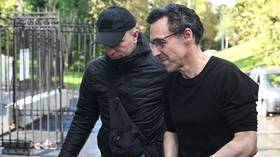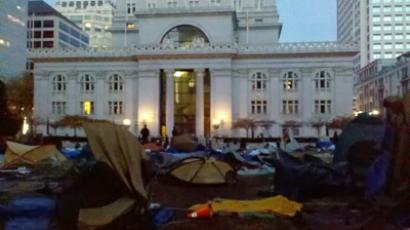Censored: #occupywallstreet

Has Twitter acted to silence Occupy Wall Street? As a new generation of protesters relies on social media to get their message across, doubts are beginning to surface that the latest tool for popular revolution is firmly in corporate hands.
As OWS protestors gathered at intersections around Wall Street Thursday, their plans to stop traders from ringing the opening bell at the New York Stock Exchange was quickly thwarted by a heavy-handed police response.With an estimated 400 arrested and demonstrators complaining of police brutality, the coordinated nationwide clampdown by local authorities is in full effect.But amid the historic level of civic protest that has not been seen in the United States in a generation, many were wondering: “Why isn’t Occupy Wall Street trending on Twitter?”
Twitter: an instrument for change?
Twitter, the online social networking service that enables users to send and read text-based posts known as “tweets,” has long been touted as a tool helping grassroots organizers foment social and political change. During the contentious 2009 Iranian presidential elections, the US State Department reportedly worked with Twitter to help expand its access in Iran. In what would ultimately be dubbed the “Twitter Revolution,” activists relied heavily on Twitter and other social networking sites as they coordinated their activities against the ruling regime.Washington was also said to have asked Twitter to delay maintenance plans so Iranian activists could communicate with each other.Likewise, social media advocates heralded the dawn of a new age when the use of Twitter became instrumental in organizing revolutions in Tunisia and Egypt, ultimately igniting the Arab Spring in late 2010/early 2011.Occupy Wall Street meanwhile, which started as a small spark in downtown New York on September 17, has since spread like wildfire around the world. Having been largely ignored by the mainstream media, the protestors in the square-block Zuccotti Park, located in the heart of New York’s financial district, did what protestors in Egypt’s Tahrir Square did; they relied on social networking sites like Twitter and Facebook to coordinate their actions.But what happened when the cyber utopians struck at the heart of an empire that Twitter itself is a part of? That is a calculation that many Occupy Wall Street Protestors apparently did not make.
Trending and Hash tags:Hash tags or pound signs (#), a user created phenomenon, a user created phenomenon, are used to group conversations on Twitter. By grouping tweets together, users can create “memes”, ideas which spread from person to person within a culture.Now, if hash tags help pool together similar ideas, trends are the ultimate expression of this, where, with the simple click of the mouse, users can access the most popular topics from the 200 million tweets sent every single day. According to Twitter’s official website, trends “are automatically generated by an algorithm that attempts to identify topics that are being talked about more right now than they were previously.”Therefore, to trend, overall volume is not the only important factor. A massive spike of interest is also necessary to make something trend on Twitter’s homepage. For example, say #britneyspears gets 1 million tweets a day, every day, for months on end. Meanwhile, #occupywallstreet has a baseline of 10,000 tweets for the first half of September. If it then spiked to 990,000 on September 17, #Occupywallstreet should trend (assuming there are not several other larger spikes of volume) while #britneyspears would not.Basically regular figures do not trend, while massive increases do.
Twiter Remains Silent
Critics have argued that at the movement’s inception on September 17 and again on October 1, when some 700 OWS protestors were arrested on the Brooklyn Bridge, #occupywallstreet did not appear on the Twitter trending list.According to some activists, on both September 17 and October 1, #occupywallstreet tweets were occurring in greater frequency than other top trending topics which appeared on Twitter’s homepage. So why did it not show up as a trend?Sean Garnett, Twitter’s vice president of communications, claimed in a statement posted on quora.com that this most likely occurred because the public “don't have access to our trends algorithm and may not have access to the full firehose of tweets.” Others have counted misspellings and other variations of phrasing that could have lead to the phenomenon.However, using Trendistic, a statistic-based trending analytic tool around, Jonathan Albright, a PhD. Researcher at the University of Auckland, said the data seems to contradict the primary arguments about how topics trend on Twitter – their relative newness, volume, and related spikes in interest.First, Albright compared #occupywallstreet with two other topics that trended on October 1; #whatyoushouldknowaboutme and #october. Comparing the data, Albright discovered that #october had been on Twitter for much longer than #occupywallstreet and did not experience a dramatically greater peak in activity. Meanwhile, #whatyoushouldknowaboutme, which trended nearly all day, had a less dramatic peak in overall tweets than #occupywallstreet.Meanwhile, Emily Chambliss from Attention, a global social media marketing agency, determined in her own statistical analysis:"In the first week, average mentions per day were an unimpressive 18.8 mentions per day. Not many people were talking about Occupy Wall Street. After the start of occupation on 9/17 and up until 9/23, average mentions per day increased by a whopping 2,004 per cent. The following week had a 97 per cent increase over the week prior, and the week after the Brooklyn Bridge arrests saw a 216 per cent increase in average mentions per day."So #occupywallstreet was relatively new, very hot, experienced great peaks in activity, but did not trend. Whatever the reason, it raises doubts about Twitter’s claim its automatically-generated algorithm “rewards discussions that are new to Twitter."
Twitter: a corporate tool
Many activists believe Twitter is working against Occupy Wall Street at the behest of corporate interests.In March of 2011, Bloomberg news reported that JPMorgan Chase & Co., arguably the largest corporate bank in the world, “has invested in a fund that has bought about $400 million in Twitter Inc. shares.With an estimated value of $4.5 billion dollars and one of the world’s major financial service providers heavily invested in it, Twitter might be a favorite tool of the “99 per cent”, but their interests obviously do not correspond with them.In the end, Twitter might be more than happy to help the US government overthrow undesirable regimes in other parts of the world. But when it comes to giving voice to those who have decided to challenge a system of corporate greed and income inequality at home, silence might ultimately figure better into their bottom line.














